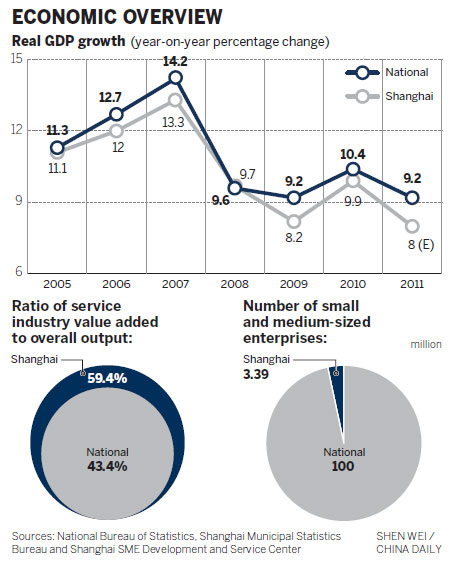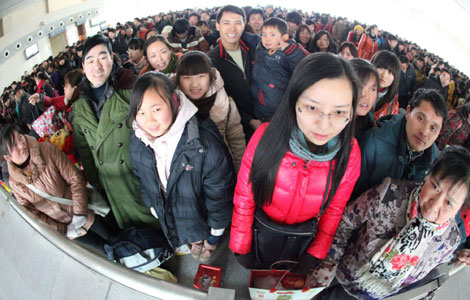Take out the old, bring in the new
Updated: 2012-01-30 08:55
By Yu Ran (China Daily)
|
|||||||||||
Shanghai aims to increase the share of the service industry to 65 percent of GDP in the next five years to meet the growing demand from its population of 23 million.
|
 |
The service industry now accounts for 60 percent of total employment, and contributes 60 percent of economic growth. The latest official figures show that the service sector accounted for at least 70 percent of the local government's fiscal revenue.
"The customer service in Shanghai is still not as good as in international cities such as New York, London and Paris, and it will take time for the city to improve its service sector, in tandem with the economic development," said Liu Xiaobing, a professor at the school of public economics and administration at Shanghai University of Finance and Economics.
Liu added that the municipal government has tried to encourage local service providers to offer a better atmosphere in shopping malls and restaurants, which he hopes will be realized soon.
Among the three main drivers of economic development - investment, customer spending and exports - customer spending has jumped to occupy pole position in the past five years with annual average retail sales of consumer goods exceeding 600 billion yuan during the period.
Figures released by the local municipal government show that consumption of daily commodities (300 billion yuan) and food (180 billion yuan) are the areas with the highest annual volume of retail sales.
"The retail industry has prepared for the restructuring of the city by providing more innovative, higher quality products and offering a more pleasant atmosphere for shopping and services to customers from Shanghai and even further away, such as the Yangtze River Delta," said Wang Liuhe, secretary-general of the Shanghai Merchandise Commercial Profession Trade Association.
Statistics from the association show that the merchandising industry increased by 11.2 percent in Shanghai in the first three quarters, of 2011, and the association wants to see an average annual increase of 10 percent in the next five years.
"Bringing the world's best-known brands to the city has become the common goal of big shopping malls, because consumers want to buy more international brands as their incomes rise," said Wang.
At present, 80 percent of the world's top brands have been introduced to Shanghai as companies opened branches and stores in shopping malls.
"Most of the big merchandising outfits that own shopping malls in the city have made it their aim to provide a greater number of high-end products from overseas and attract customers by offering better services," said Wang.
Along with these companies, around 50 percent of the city's small and medium-sized shops are now selling private brands at reasonable prices.
"As a private seller of clothes and accessories that are not branded, my shop enables people from the middle- and lower-classes to buy what they want at lower prices than at the shopping malls," said Shen Wei, the owner of the Xiao Wei (Little Wei) clothes shop in Shanghai which sells women's clothes manufactured in Guangdong province alongside garments imported from South Korea.
Shen added that the market malls and unbranded goods in shops like hers is quite balanced and essential to meet the demands from people in the city.
In addition, putting greater focus on the trading and logistics industries, especially in private SMEs, has been set as the next procedure in the restructuring of the city.
Statistics from Shanghai Customs show that the export and import volumes of the city's private companies exceeded $125 billion in the first three quarters of 2011, 27.2 percent higher than State-owned outfits and with a rate of growth of 33.5 percent, compared with the same period in 2010.
"There are many privately owned trading companies in Shanghai now, including some that have moved from other smaller cities because of the Shanghai's rapid development as a trading center," said Huang Yi, manager of the vehicle equipment exporter Shanghai Qinfen Trading Co Ltd.
Huang added that most of Shanghai's manufacturers and suppliers have applied high-technology to the production process to meet the increasing high-end demand from overseas clients.
However, the trading structure of the city is also changing, with the import volume gradually overtaking exports.
The import volume in Shanghai in the first three quarters of 2011 was 7 percent higher than the export volume, with a difference of nearly 11.5 billion yuan.
Shen Xiuqing, the owner of Shanghai Qingyuan Economic & Trading Co Ltd, has switched the focus of her company away from furniture exports to the import of durian (a delicious, but extremely smelly, fruit).
The change in focus came after export orders fell dramatically in the wake of the global financial meltdown in 2008.
"I've noticed that more people are willing to try imported foods, especially fruit such as durian, so in 2009 I became the first Chinese importer of Malaysian durian and the business is going quite well," said Shen.
Shen added that she plans to import more foodstuffs from other countries as more residents realize that eating imported food and being more experimental is a new trend in modern lifestyle.
Since 2009, Shanghai's municipal government has launched a development strategy to speed up the service industry, including finance, trading, information services and innovative industry, with the help of SMEs.
"SMEs should restructure their industrial structure by upgrading innovative products and providing better after-sales services," said Zhang Huiming, director of the Enterprise Research Institute at Fudan University in Shanghai.
Zhang added that finding workers who've been given professional training is also extremely important for SMEs to help to restructure the employee groups and produce higher quality products.
Indeed, among the people who have benefited most from the growth and expansion of the service sector are the tens of thousands of migrant workers who have found ample new opportunities to move up the social ladder in this famously competitive town.
Take 24-year-old Ma Chao for instance. He left his hometown of Yancheng in Jiangsu province after graduating from technical college in 2009 to try his luck in Shanghai. He said he was lucky to have come at a time when demand for better-educated migrant workers was beginning to rise in the service sector.
"I was offered a number of jobs, but chose my present one working at the sales department of a local chemical company," he said. His job, which mainly involves servicing the needs of clients, pays a monthly salary of 3,500 yuan, which, he said, is "better than expected".
What's more, "there are many opportunities in my area", he said.
Hot Topics
Kim Jong-il, Mengniu, train crash probe, Vaclav Havel, New Year, coast guard death, Internet security, Mekong River, Strait of Hormuz, economic work conference
Editor's Picks

|

|

|

|

|

|







